 Stuy Cove Park was designated as a Monarch Way Station more than a decade ago, and we’ve had as many as four native milkweeds growing in the park at a time. These amazing pollinators, which famously undertake an epic migration from Canada to Mexico each year, have been seeing their numbers drastically decline as over the past 30 years or so.
Stuy Cove Park was designated as a Monarch Way Station more than a decade ago, and we’ve had as many as four native milkweeds growing in the park at a time. These amazing pollinators, which famously undertake an epic migration from Canada to Mexico each year, have been seeing their numbers drastically decline as over the past 30 years or so.
Now the International Union of Conservation of Nature (IUCN) has placed the North American Monarch, on its list of endangered species. IUCN is considered the world’s most authoritative wildlife monitoring organization.
However, while the future of this wonderful creature is uncertain, it is far from hopeless, and unlike the conservation of more exotic species, there’s a lot that ordinary people can do to help restore Monarch butterfly populations before it’s too late.
Monarch caterpillars are picky eaters- they are only interested in the leaves of milkweed plants. Female butterflies deposit eggs on milkweed plants from Texas to Canada in the spring, and native species are the ones gardeners should cultivate. This genus, Asclepias in Latin, includes plants found all over the world, but some of the ones native to the Eastern U.S. include Asclepias incarnata (Swamp milkweed), Asclepias syriaca (Common milkweed), and Asclepias tuberosa (Butterfly milkweed).
In addition to milkweed for the caterpillar stage, it’s important to plant nectar-giving flowers that bloom between June and September so the adult butterflies also have something to eat. Some great choices include bergamot or bee balm (Monarda), Golden Alexander (Zizia), asters (Symphyotricum), and Carolina or Virginia roses.
In addition to habitat loss, Monarchs are also being negatively impacted by the use of glyphosate herbicide, marketed as Roundup. In addition to being toxic to milkweeds, there’s mounting evidence that glyphosate isn’t safe for humans either.
The increasing interest in native plants and pollinator gardens has stabilized Monarch populations in recent years…but not quite to the point where they can be considered sustainable. So the more help we can offer them, the more likely it is that Monarchs will continue to appear and delight us each summer.
You can read more about this on the NY Times website here.

